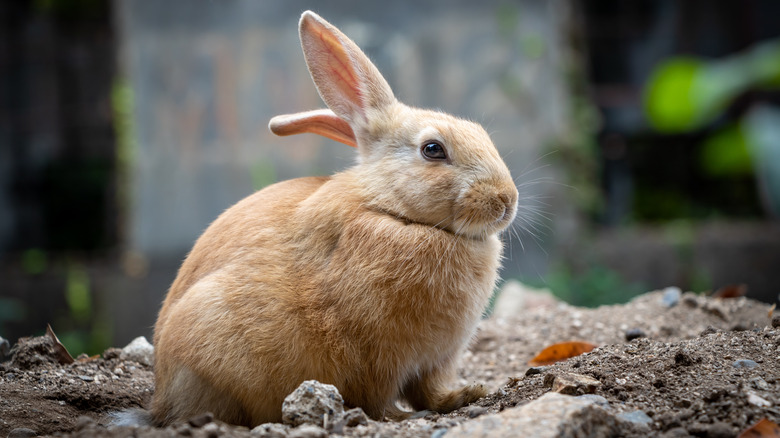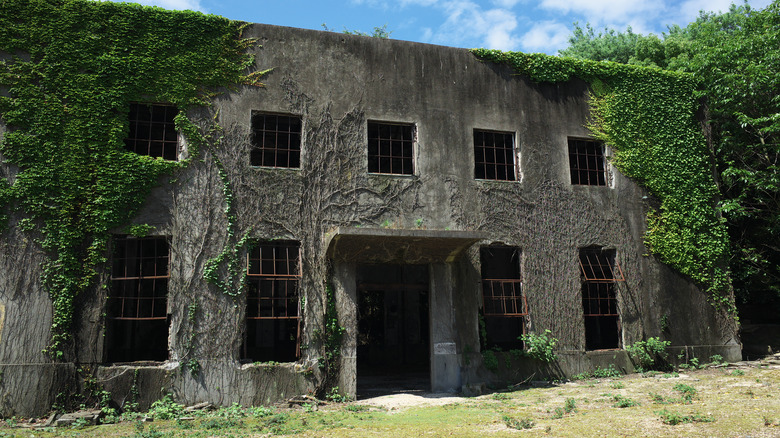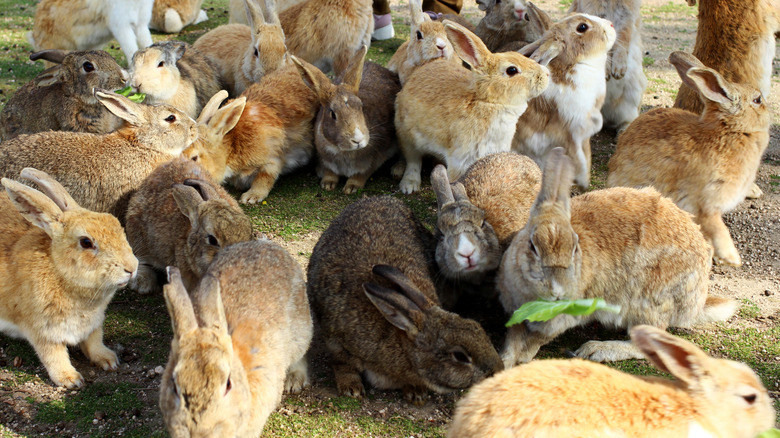The Haunting Origin Story Behind Japan's Rabbit Island
Located near Takehara, Japan, Okunoshima is a small island that is home to 900 wild rabbits (via Hiroshima for Global Peace). According to Smithsonian Magazine, the island is colloquially known as Usagi Jima, or Rabbit Island. As it is only two miles off the coast of Takehara and a short ferry ride away, the Los Angeles Times adds that it's a popular destination for both tourists and locals alike. Rabbit Island's website notes that visiting is considered to be good luck due to the positive symbolism of rabbits. However, there are rules when it comes to interacting with the island's fluffy inhabitants.
Per Rabbit Island's website, visitors are discouraged from holding the rabbits or feeding them certain foods, such as potatoes. In addition, visitors are warned against taking a rabbit or abandoning their own pet rabbit on the island, amongst other things. Besides having fun in the sun with the rabbits, tourists can also opt to visit the island's Poison Gas Museum (per The Guardian). Long before it was known as Rabbit Island, Hiroshima for Global Peace writes that it was referred to as "the island that was erased from the map." For years, the island's existence remained hidden to prevent the world from knowing what was really happening on Okunoshima.
The island was used to produce poison
According to Hiroshima for Global Peace, the Japanese army used Okunoshima to make poisonous gas for World War II between 1929 and 1945. The Guardian reports that 6,000 tons were produced within these years. An article from The New York Times explains that this includes mustard gas, phosgene, and more. It's believed that 80,000 Chinese individuals may have died from the gasses made on Okunoshima during the war. The Los Angeles Times explains that Okunoshima's location made it ideal for producing these gasses — the Japanese found that they could easily transport workers to and from the island while still keeping it a secret from the public. Author Walter Grunden told the Los Angeles Times, "It's the perfect place for an operation like this. If a toxic cloud is released, it won't waft onto a city or something. You don't have people poking around."
Per The New York Times, Okunoshima was discovered by American soldiers after the end of World War II. They then dumped 5,000 tons of the poisonous gas into the water surrounding the island. The publication goes on to say that many Japanese citizens are simply unaware of the existence of the island and its Poison Gas Museum. Hiroshima for Global Peace states that the museum was built in 1988 in hopes that it would educate Japan on the atrocities caused by the gas produced on the island. The ruins of the gas factories can also be viewed by visitors, and the rabbits are an added bonus to this experience.
It's unknown how the rabbits came to the island
Per Smithsonian Magazine, the rabbits' origins are vague, but there are theories. The Guardian states that the rabbits were brought to the island as test subjects. When the war ended, they were freed and eventually multiplied. However, Ellis Krauss from the University of California San Diego told The Dodo that this was not the case. He stated, "The rabbits are not descendants used in chemical weapons tested during the war." He added, "The test rabbits were all euthanized by the Americans when they came to the island during the Occupation ... about 200 of the poor things were being [used] in experiments by the Japanese."
The Los Angeles Times reports that perhaps the rabbits were left on the island by school children. Smithsonian Magazine infers that this occurred in 1971. As there were no cats or dogs on the island, the rabbit population exploded. The Dodo states that Krauss further explained that the survival of these rabbits would not be possible without the tourists that now visit the island. Due to the production of poisonous gasses, the water on Okunoshima is "toxic."
Krauss explained (via The Dodo), "All water is bottled water imported to the island for humans — and then people put out water for the rabbits around the island as well." However, according to Smithsonian Magazine, the tourists are also negatively affecting the rabbits' health and Okunoshima's ecosystem. In particular, they have created an "unsustainable population boom" — if they don't visit, the rabbits don't get fed as much, creating a "boom and bust cycle." Without tourists, there is little plant life for the rabbits to survive on.


